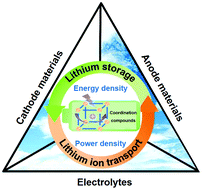当前位置:
X-MOL 学术
›
Chem. Soc. Rev.
›
论文详情
Our official English website, www.x-mol.net, welcomes your
feedback! (Note: you will need to create a separate account there.)
Coordination compounds in lithium storage and lithium-ion transport
Chemical Society Reviews ( IF 40.4 ) Pub Date : 2020/02/25 , DOI: 10.1039/c9cs00881k Jingwei Liu 1, 2, 3, 4, 5 , Daixi Xie 1, 2, 3, 4, 5 , Wei Shi 1, 2, 3, 4, 5 , Peng Cheng 1, 2, 3, 4, 5
Chemical Society Reviews ( IF 40.4 ) Pub Date : 2020/02/25 , DOI: 10.1039/c9cs00881k Jingwei Liu 1, 2, 3, 4, 5 , Daixi Xie 1, 2, 3, 4, 5 , Wei Shi 1, 2, 3, 4, 5 , Peng Cheng 1, 2, 3, 4, 5
Affiliation

|
Lithium-ion batteries (LIBs) have enabled wireless revolution of portable digital products. However, for high-performance applications such as large-scale energy storage and next-generation portable devices, the energy and power densities as well as the cycle life of LIBs still need to be further enhanced. This can be realized by improving the electrochemical performance of the three main components of LIBs: cathode, anode, and electrolyte. In addition to LIBs, lithium–metal batteries (LMBs) have also attracted considerable attention owing to their ultra-high energy density arising from the lithium–metal anode. However, LMB performance is currently limited by dendrite formation and poor interfacial contact between electrode and electrolyte. Herein we highlight the applications of coordination chemistry in LIBs and LMBs, especially for realization of promising next-generation electrode and electrolyte materials based on coordination compounds with well-defined molecular structures. We start by introducing the development of coordination chemistry from discrete coordination compounds to coordination polymers and metal–organic frameworks. Then, we present the design strategies of coordination compounds for lithium storage and lithium-ion transport. Approaches to enhance the electrochemical properties, working potential, capacity, cycling stability, and rate capability of coordination compound-based electrodes are discussed in detail. The reticular chemistry endowing metal–organic frameworks with desired structures and pore metrics as electrolytes for lithium-ion transmission is also summarized. Finally, the current challenges and promising research directions of coordination chemistry for LIBs and LMBs are presented.
中文翻译:

锂存储和锂离子运输中的配位化合物
锂离子电池(LIB)推动了便携式数字产品的无线革命。但是,对于诸如大型储能和下一代便携式设备之类的高性能应用,LIB的能量和功率密度以及循环寿命仍需要进一步提高。这可以通过改善LIB的三个主要成分的电化学性能来实现:阴极,阳极和电解质。除了锂电池,锂金属电池(LMB)也因其锂金属阳极产生的超高能量密度而引起了广泛关注。然而,LMB性能目前受到枝晶形成以及电极与电解质之间不良界面接触的限制。本文重点介绍了配位化学在LIB和LMB中的应用,特别是用于实现具有良好分子结构的配位化合物的下一代电极和电解质材料。我们首先介绍配位化学的发展,从离散配位化合物到配位聚合物和金属有机骨架。然后,我们提出了用于锂存储和锂离子运输的配位化合物的设计策略。详细讨论了增强配位化合物基电极的电化学性能,工作电势,容量,循环稳定性和速率能力的方法。还总结了网状化学赋予金属-有机骨架以所需的结构和孔隙度,作为锂离子传输的电解质。最后,
更新日期:2020-03-24
中文翻译:

锂存储和锂离子运输中的配位化合物
锂离子电池(LIB)推动了便携式数字产品的无线革命。但是,对于诸如大型储能和下一代便携式设备之类的高性能应用,LIB的能量和功率密度以及循环寿命仍需要进一步提高。这可以通过改善LIB的三个主要成分的电化学性能来实现:阴极,阳极和电解质。除了锂电池,锂金属电池(LMB)也因其锂金属阳极产生的超高能量密度而引起了广泛关注。然而,LMB性能目前受到枝晶形成以及电极与电解质之间不良界面接触的限制。本文重点介绍了配位化学在LIB和LMB中的应用,特别是用于实现具有良好分子结构的配位化合物的下一代电极和电解质材料。我们首先介绍配位化学的发展,从离散配位化合物到配位聚合物和金属有机骨架。然后,我们提出了用于锂存储和锂离子运输的配位化合物的设计策略。详细讨论了增强配位化合物基电极的电化学性能,工作电势,容量,循环稳定性和速率能力的方法。还总结了网状化学赋予金属-有机骨架以所需的结构和孔隙度,作为锂离子传输的电解质。最后,











































 京公网安备 11010802027423号
京公网安备 11010802027423号